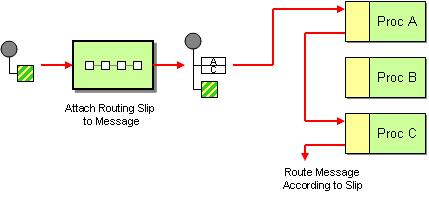...
Routing
...
Slip
...
The
...
...
...
from
...
the
...
...
...
allows
...
you
...
to
...
route
...
a
...
message
...
consecutively
...
through
...
a
...
series
...
of
...
processing
...
steps
...
where
...
the
...
sequence
...
of
...
steps
...
is
...
not
...
known
...
at
...
design
...
time
...
and
...
can
...
vary
...
for
...
each
...
message.
Options
...
Name | Default Value | Description |
|---|---|---|
|
| Delimiter used if the Expression returned multiple endpoints. |
|
| If an endpoint URI could not be resolved, should it be ignored. Otherwise, Camel will throw an exception stating the endpoint URI is not valid. |
|
| Camel 2.13.1/2.12.4: Allows to configure the cache size for the The default cache size is A value of |
Example
The following route will take any messages sent to the Apache ActiveMQ queue SomeQueue and pass them into the Routing Slip pattern.
...
Messages will be checked for the existence of the aRoutingSlipHeader header. The value of this header should be a comma-delimited list of endpoint URIs you wish the message to be routed to. The Message will be routed in a pipeline fashion, i.e., one after the other. From Camel 2.5 the Routing Slip will set a property, Exchange.SLIP_ENDPOINT, on the Exchange which contains the current endpoint as it advanced though the slip. This allows you to know how far we have processed in the slip.
The Routing Slip will compute the slip beforehand which means, the slip is only computed once. If you need to compute the slip on-the-fly then use the Dynamic Router pattern instead.
Configuration Options
Here we set the header name and the URI delimiter to something different.
Using the Fluent Builders
...
Using
...
the
...
...
...
...
Ignore Invalid Endpoints
Available as of Camel 2.3
The Routing Slip now supports ignoreInvalidEndpoints which the Recipient List also supports. You can use it to skip endpoints which are invalid.
...
And in Spring XML its an attribute on the recipient list tag:
...
Then let's say the myHeader contains the following two endpoints direct:foo,xxx:bar
...
.
...
The
...
first
...
endpoint
...
is
...
valid
...
and
...
works.
...
However
...
the
...
second endpoint is
...
invalid
...
and
...
will
...
just
...
be
...
ignored.
...
Camel
...
logs
...
at INFO
...
level,
...
so
...
you
...
can
...
see
...
why
...
the
...
endpoint
...
was
...
invalid.
...
Expression Support
Available as of Camel 2.4
...
The
...
...
...
now
...
supports
...
to
...
take
...
the
...
expression
...
parameter
...
as
...
the
...
...
...
does.
...
You
...
can
...
tell
...
Camel
...
the
...
expression
...
that
...
you
...
want
...
to
...
use
...
to
...
get
...
the
...
routing
...
slip.
...
...
And in Spring XML its an attribute on the recipient list tag.
...
Further Examples
For further examples of this pattern in use you could look at the routing slip test cases.
